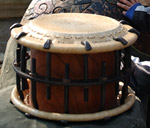Kids Web Japan
Web Japan > Kids Web Japan > Meet the Kids > Taiko > Taiko Basics
Meet the Kids
Taiko
Taiko Basics

A tsukeshime-daiko
A taiko is a drum made from an open-ended wooden barrel with animal skin stretched over both ends. It is played with two bachi (wooden sticks).
There are two distinct methods of fitting the animal skin to the drums. Those that have skins tacked directly onto both ends are collectively called byodome-daiko. These are easy to use and, therefore, commonly played in performances and at local festivals. These days byodome-daiko are made from the wood of the keyaki (zelkova) tree or something similar, with cowhide or horsehide stretched across the ends. A section of the desired length is cut from a carefully selected tree of the correct thickness and then hollowed out. This takes a lot of time and effort, so byodome-daiko are very expensive, and their owners use them for many years, replacing the horsehide whenever it gets too worn.
A tsukeshime-daiko is made a bit differently. A number of holes are made around the edges of two pieces of thick cowhide or horsehide stretched on round frames, which are placed across the ends of the barrel. Hemp twine is then passed through the holes and along the length of the drum, pulling the two pieces of cowhide or horsehide tight. The distinctive sound of each drum is determined by how tightly the hemp twine has been fitted. The drums used in noh and kabuki are of this kind and are known as noh-daiko.
There are also some taiko made from staves, or strips, of wood instead of a single hollowed-out block, with cowhide or horsehide stretched across the ends. These are called okedo-daiko. They come in all sizes, and the smaller ones can be carried on a strap hanging across the player's shoulder, so they are very useful for parades.
The largest taiko ever made was 4.8 meters in diameter. It was made by Asano Taiko in Ishikawa Prefecture and is listed in the Guiness Book of Records.